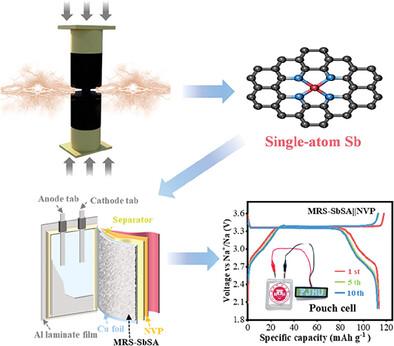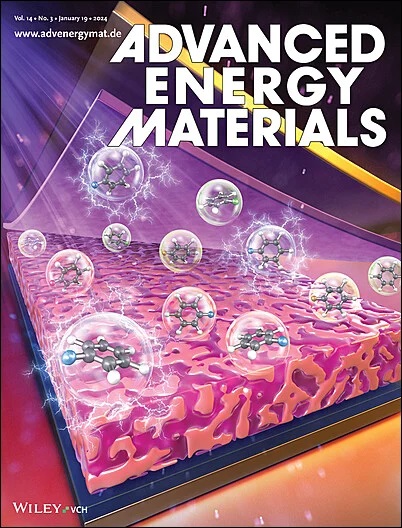Highly Reversible Sodium Metal Batteries Enabled by Extraordinary Alloying Reaction of Single‐Atom Antimony
IF 24.4
1区 材料科学
Q1 CHEMISTRY, PHYSICAL
引用次数: 0
Abstract
The unique coordination configuration of single‐atom materials (SAMs) allows precise reaction control at atomic‐level and a potential of unusual electrochemical reaction. Nevertheless, it is a big challenge to prepare main group element with high loading content. Here, multifield‐regulated synthesis (MRS) technology is utilized to rapidly produce single‐atom antimony (Sb) metal with a high loading of 15 wt.%. Ab initio molecular dynamics simulations reveal the significantly enhanced reaction kinetics of Sb and nitrogen‐doped graphene by multi‐physics field coupling. Compared with common metallic Sb nanoparticles, atomically dispersed Sb displays remarkably improved electrochemical reaction kinetics and stable structure due to the negligible variation of stresses and volume expansion during the pseudocapacitive alloying‐dealloying process. Such extraordinary alloying reaction in well‐dispersed Sb atoms enabling homogeneous ion flow can serve as active nucleation sites for regulating even Na metal nucleation and growth. As a result, copper foil coated with only ≈3 µm thickness of such material exhibits a high Coulombic efficiency of up to 99.99%, an ultra‐low overpotential of 3 mV, and a long lifetime exceeding 2500 h in symmetrical cells. Furthermore, an anode‐free MRS‐SbSA||Na

通过单原子锑的非凡合金化反应实现高度可逆的金属钠电池
单原子材料(SAMs)独特的配位构型允许在原子水平上进行精确的反应控制,并有可能发生不寻常的电化学反应。然而,制备高负载量的主族元素是一项巨大的挑战。在此,我们利用多场调控合成(MRS)技术快速制备出了单原子金属锑(Sb),其负载量高达 15 wt.%。Ab initio 分子动力学模拟显示,通过多物理场耦合,锑和掺氮石墨烯的反应动力学显著增强。与普通的金属锑纳米颗粒相比,原子分散的锑在伪电容合金化-合金化过程中的应力变化和体积膨胀可以忽略不计,因此电化学反应动力学得到了明显改善,结构也更加稳定。在均匀分散的 Sb 原子中发生的这种非凡的合金化反应使离子能够均匀流动,可作为调节 Na 金属成核和生长的活性成核点。因此,镀有厚度仅为 ≈3 µm 的此类材料的铜箔具有高达 99.99% 的库仑效率、3 mV 的超低过电位以及超过 2500 小时的对称电池寿命。此外,还构建了无阳极 MRS-SbSA||Na3V2(PO4)3 电池,该电池具有极高的能量密度(≈362 Wh Kg-1)、出色的速率能力和良好的循环稳定性。
本文章由计算机程序翻译,如有差异,请以英文原文为准。
求助全文
约1分钟内获得全文
求助全文
来源期刊

Advanced Energy Materials
CHEMISTRY, PHYSICAL-ENERGY & FUELS
CiteScore
41.90
自引率
4.00%
发文量
889
审稿时长
1.4 months
期刊介绍:
Established in 2011, Advanced Energy Materials is an international, interdisciplinary, English-language journal that focuses on materials used in energy harvesting, conversion, and storage. It is regarded as a top-quality journal alongside Advanced Materials, Advanced Functional Materials, and Small.
With a 2022 Impact Factor of 27.8, Advanced Energy Materials is considered a prime source for the best energy-related research. The journal covers a wide range of topics in energy-related research, including organic and inorganic photovoltaics, batteries and supercapacitors, fuel cells, hydrogen generation and storage, thermoelectrics, water splitting and photocatalysis, solar fuels and thermosolar power, magnetocalorics, and piezoelectronics.
The readership of Advanced Energy Materials includes materials scientists, chemists, physicists, and engineers in both academia and industry. The journal is indexed in various databases and collections, such as Advanced Technologies & Aerospace Database, FIZ Karlsruhe, INSPEC (IET), Science Citation Index Expanded, Technology Collection, and Web of Science, among others.
 求助内容:
求助内容: 应助结果提醒方式:
应助结果提醒方式:


